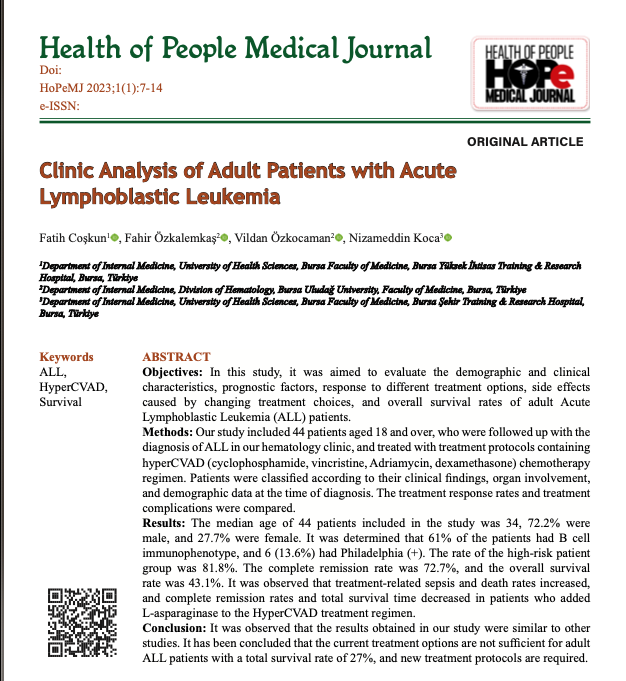The Clinic Analysis of Adult Patients with Acute Lymphoblastic Leukemia
Keywords:
ALL, HyperCVAD, SurvivalAbstract
Abstract
Objectives: In this study, it was aimed to evaluate the demographic and clinical characteristics, prognostic factors, response to different treatment options, side effects caused by changing treatment choices, and overall survival rates of adult Acute Lymphoblastic Leukemia (ALL) patients.
Methods: Our study included 44 patients aged 18 and over, who were followed up with the diagnosis of ALL in our hematology clinic, and treated with treatment protocols containing hyperCVAD (cyclophosphamide, vincristine, Adriamycin, dexamethasone) chemotherapy regimen. Patients were classified according to their clinical findings, organ involvement, and demographic data at the time of diagnosis. The treatment response rates and treatment complications were compared.
Results: The median age of 44 patients included in the study was 34, 72.2% were male, and 27.7% were female. It was determined that 61% of the patients had B cell immunophenotype, and 6 (13.6%) had Philadelphia (+). The rate of the high-risk patient group was 81.8%. The complete remission rate was 72.7%, and the overall survival rate was 43.1%. It was observed that treatment-related sepsis and death rates increased, and complete remission rates and total survival time decreased in patients who added L-asparaginase to the HyperCVAD treatment regimen.
Conclusion: It was observed that the results obtained in our study were similar to other studies. It has been concluded that the current treatment options are not sufficient for adult ALL patients with a total survival rate of 27%, and new treatment protocols are required.
References
Wartenberg, D., Groves, F. D., & Adelman, A. S. (2008). Acute lymphoblastic leukemia: epidemiology and etiology. In Acute leukemias (pp. 77-93). Springer, Berlin, Heidelberg.
Yang, X., Chen, H., Man, J., Zhang, T., Yin, X., He, Q., & Lu, M. (2021). Secular trends in the incidence and survival of all leukemia types in the United States from 1975 to 2017. Journal of Cancer, 12(8), 2326.
Redaelli, A., Laskin, B. L., Stephens, J. M., Botteman, M. F., & Pashos, C. L. (2005). A systematic literature review of the clinical and epidemiological burden of acute lymphoblastic leukaemia (ALL). European journal of cancer care, 14(1), 53-62.
Dores, G. M., Devesa, S. S., Curtis, R. E., Linet, M. S., & Morton, L. M. (2012). Acute leukemia incidence and patient survival among children and adults in the United States, 2001-2007. Blood, The Journal of the American Society of Hematology, 119(1), 34-43.
Malard, F., & Mohty, M. (2020). Acute lymphoblastic leukaemia. The Lancet, 395(10230), 1146-1162.
Manola, K. N. (2013). Cytogenetic abnormalities in acute leukaemia of ambiguous lineage: an overview. British journal of haematology, 163(1), 24-39.
Rowe JM, Buck G, Burnett AK, et al. Induction therapy for adults with acute lymphoblastic leukemia: results of more than 1500 patients from the international ALL trial: MRC UKALL XII/ECOG E2993. Blood 2005;106:3760-67.
Rowe JM, Richards S, Wiernik PH, et al. Allogenic bone marrow transplantation (BMT) for adults with acute lymphoblastic leukemia (ALL) in first complete remission (CR): Early results from the international ALL trial (MRC UKALL/ECOG E2993). Blood 2005;12:3760-7.
Douer, D., Gökbuget, N., Stock, W., & Boissel, N. (2021). Optimizing use of L-asparaginase–based treatment of adults with acute lymphoblastic leukemia. Blood Reviews, 100908.
Sive, J. I., Buck, G., Fielding, A., Lazarus, H. M., Litzow, M. R., Luger, S., ... & Goldstone, A. H. (2012). Outcomes in older adults with acute lymphoblastic leukaemia (ALL): results from the international MRC UKALL XII/ECOG 2993 trial. British journal of haematology, 157(4), 463-471.
Hoelzer D, Thiel E, Loffler H, et al. Prognostic factors in a multicenter study for treatment of acute lymphoblastic leukemia in adults. Blood 1988;71:123-31.
Hoelzer, D., Bassan, R., Dombret, H., Fielding, A., Ribera, J. M., & Buske, C. (2016). Acute lymphoblastic leukaemia in adult patients: ESMO Clinical Practice Guidelines for diagnosis, treatment and follow-up. Annals of Oncology, 27, v69-v82
Rowe, J. M. (2010). Prognostic factors in adult acute lymphoblastic leukaemia. British journal of haematology, 150(4), 389-405.

Downloads
Published
How to Cite
Issue
Section
License
Copyright (c) 2023 Health of People Medical Journal

This work is licensed under a Creative Commons Attribution-NonCommercial-NoDerivatives 4.0 International License.
The Editorial Board of the Health of People Medical Journal complies with the criteria of the International Council of Medical Journal Editors (ICMJE), the World Association of Medical Editors (WAME), and the Committee on Publication Ethics (COPE).
1. All editorial members, reviewers, and authors must confirm and obey the rules defined by COPE.
2. The corresponding author is the main owner of the article, so she/he can withdraw the article when it is incomplete (before entering the review process or when a revision is asked for).
3. Authors cannot make major changes in the article after acceptance without a serious reason.
4. All editorial members and authors must will to publish any corrections honestly and completely.
5. Any notes of plagiarism, fraudulent data, or other kinds of fraud must be reported completely to COPE.




